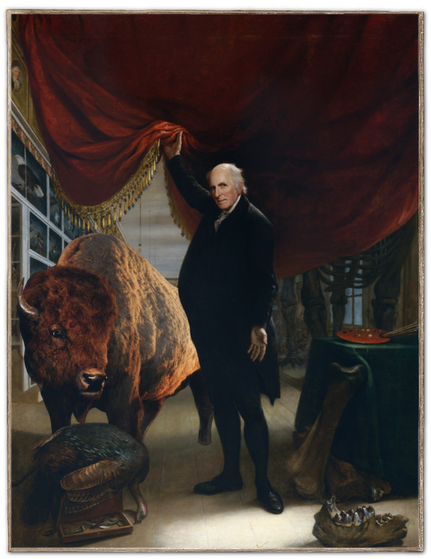The Artist in His Museum
Charles Willson Peale, 1822
"Nobody knows how to throw a dinner party better than the 19th-century Renaissance man Charles Willson Peale.
"Peale, a scholar, an artist, an inventor, a dentist, a doctor, a poet, a naturalist ... held a party in 1802 on a chilly February night in Philadelphia. It was a fine affair. Notable for one dramatic detail, Peale’s friends and family sat graciously at table, sipping wine and laughing, inside the belly of a mastodon skeleton.
"Peale’s dinner party is emblematic of the kind of seat-of-the-pants, free-wheeling spirit that emboldened the nation as it pursued the sciences with unprecedented zeal. Everyday citizens crowded lecture halls and devoted themselves to the sciences. Inventors applied for hundreds of thousands of patents. And artists and photographers and illustrators began to document the country’s seemingly endless bounty.
"So that night, Peale’s guests raised their glasses and toasted the occasion. [One can] imagine, how the host’s guests, sitting in the glowing candle light, must have marveled at the shifting shadows on the wall of the great mastodon’s tusks. And Peale likely delighted his visitors with the dramatic story of how he had come to extricate the fossil bones of the great Pleistocene beast from the watery mud of a bog on the property of a New York farmer.
"The skeleton became the centerpiece of Peale’s Philadelphia museum, depicted in the self-portrait, The Artist in His Museum. Here, the artist portrays the fossils and taxidermic specimens, the arts, the mechanical marvels, all of which, both in the painting and in real life, Peale dedicated to the citizens of the United States..."
"Peale, a scholar, an artist, an inventor, a dentist, a doctor, a poet, a naturalist ... held a party in 1802 on a chilly February night in Philadelphia. It was a fine affair. Notable for one dramatic detail, Peale’s friends and family sat graciously at table, sipping wine and laughing, inside the belly of a mastodon skeleton.
"Peale’s dinner party is emblematic of the kind of seat-of-the-pants, free-wheeling spirit that emboldened the nation as it pursued the sciences with unprecedented zeal. Everyday citizens crowded lecture halls and devoted themselves to the sciences. Inventors applied for hundreds of thousands of patents. And artists and photographers and illustrators began to document the country’s seemingly endless bounty.
"So that night, Peale’s guests raised their glasses and toasted the occasion. [One can] imagine, how the host’s guests, sitting in the glowing candle light, must have marveled at the shifting shadows on the wall of the great mastodon’s tusks. And Peale likely delighted his visitors with the dramatic story of how he had come to extricate the fossil bones of the great Pleistocene beast from the watery mud of a bog on the property of a New York farmer.
"The skeleton became the centerpiece of Peale’s Philadelphia museum, depicted in the self-portrait, The Artist in His Museum. Here, the artist portrays the fossils and taxidermic specimens, the arts, the mechanical marvels, all of which, both in the painting and in real life, Peale dedicated to the citizens of the United States..."
Excerpted from "The Great Hall of American Wonders Opens Today at American Art," by Beth Py-Lieberman. Smithsonian Magazine, July 15, 2011. https://www.smithsonianmag.com/smithsonian-institution/the-great-hall-of-american-wonders-opens-today-at-american-art-31832317/
See also, "The Story of Charles Willson Peale's Massive Mastodon," by Hans-Dieter Sues. Smithsonian Magazine, May 6, 2020. https://www.smithsonianmag.com/smithsonian-institution/story-charles-willson-peales-massive-mastodon-180974384/
See also, "The Story of Charles Willson Peale's Massive Mastodon," by Hans-Dieter Sues. Smithsonian Magazine, May 6, 2020. https://www.smithsonianmag.com/smithsonian-institution/story-charles-willson-peales-massive-mastodon-180974384/
AUTHOR'S NOTE: In 1786, artist and antiquarian Charles Willson Peale founded the nation's first public museum of natural history, in Philadelphia. Years later, in 1822, viewers of Peale's original self-portrait glimpsed the bones of his fantastic mastodon (at center-right), as the artist-turned-showman sweeps open the curtain to his museum. For the collage used on this Web site, a major element has been inserted into Peale's original work. In a nod to the artistic unity of museum display, the Great Bull from William Hornaday's American Bison Group -- shown here fully-restored and under lights for a film sequence -- appears at center left, as Peale himself beckons entry. The original painting hangs today in the Pennsylvania Academy of Fine Arts, also founded by Charles Willson Peale.
Special thanks to graphic artist Violet Ray for producing this engaging image.
Special thanks to graphic artist Violet Ray for producing this engaging image.


